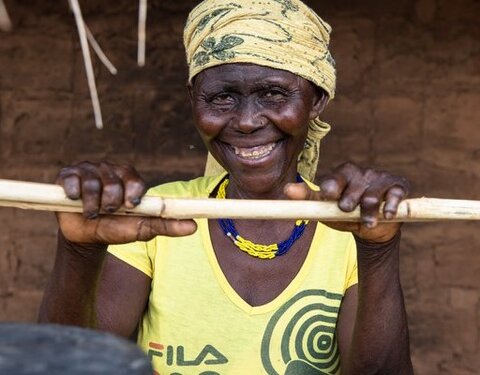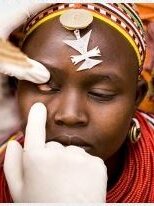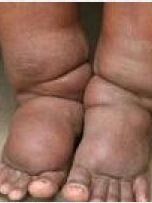Disease-Specific Groups
The disease-specific groups provide a forum for members to come together to identify areas of common concern and opportunities for integration and collaboration. New disease-specific groups can join the NNN with the agreement of the Executive Committee. Each disease-specific group has representation on the Executive Committee which is decided by the respective group. Below you can find our existing disease-specific groups.
Onchocerciasis NGOs for Elimination (ONE)
Onchocerciasis, also known as river blindness, is a parasitic disease caused by the parasite onchocerca volvulus, transmitted by multiple bites of a black fly that breeds near fast flowing rivers. As the parasite multiplies in the body, its offspring, called microfilariae, invade the skin and cause intense rashes and debilitating itching. When microfilariae enter the eyes, they cause an inflammatory response; long-term this leads to visual impairment and, ultimately, blindness.
Communities affected by river blindness are known to abandon rich farmland to escape the disease. The symptoms of the disease interfere with the ability of adults to work and raise their families and the ability of children to grow and learn. A single, annual dose of Mectizan given to eligible patients controls the disease and relieves the symptoms. After two decades of free Mectizan, some countries in Latin America have achieved the elimination of transmission of the disease and are now stopping treatment. It is now hoped that elimination is also feasible in Africa.
Chair: Lindsay Rakers (The Carter Center - lindsay [dot] rakers [at] cartercenter [dot] org)
Vice-Chair: Juliana Amanyi-Enegela (CBM - juliana [dot] amanyi-enegela [at] cbm [dot] org)
Past Chair: Francesca Olamiju (MITOSATH - olamijufo [at] mitosath [dot] org)
Trachoma group
Trachoma is the world’s leading infectious cause of blindness. It is caused by infection from the bacterium Chlamydia trachomatis which presents in young children as a chronic inflammation of the eye lid. Infection from person to person spreads through contact with eye discharge from an infected person – via hands, towels, sheets and, in some cases, eye-seeking flies, and thrives where there is poor sanitation and limited access to clean water for personal hygiene.
Repeated re-infection over time damages the eyelids and can cause scarring of the eyelid, which leads to eyelashes turning inwards and rubbing painfully against the eyeball surface. This advanced stage of the disease, trachomatous trichiasis (or TT), is extremely painful and results in scarring of the cornea. It has a profoundly negative impact on an individual’s quality of life. Trichiasis can be corrected by eyelid surgery, however, if left untreated, it may lead to irreversible low vision and blindness.
To combat trachoma, WHO has endorsed a comprehensive package of interventions known as the SAFE strategy. This strategy includes:
- Surgery to correct trachomatous trichiasis, the late blinding stage of trachoma
- Antibiotics for C. trachomatis infection
- Facial cleanliness to reduce transmission and infection
- Environmental improvement to reduce risk of transmission and infection
To learn more about trachoma or the work of this group of trachoma stakeholders please visit The International Coalition for Trachoma website.
Chair: PJ Hooper (phooper [at] taskforce [dot] org)
Vice Chair: Sarity Dodson sdodson [at] hollows [dot] org
Schistosomiasis and Soil-transmitted helminth group

Schistosomiasis is a water-borne disease caused by parasitic flatworms called schistosomes. Larval forms of these parasites are released by freshwater snails into waterbodies such as lakes and rivers. These larvae penetrate the skin of people using the water to wash, clean, drink or bathe. The flatworms live in the blood vessels and release eggs, some of which are passed out of the body through stool and urine, while others are trapped in body tissues, resulting in tissue and organ damage. Damage to organs like the intestines, liver and spleen is termed intestinal schistosomiasis and can result in portal hypertension and liver failure, whilst damage to the bladder, kidneys and reproductive organs is urogenital schistosomiasis and can lead to bladder cancer, genital lesions and increased risk of HIV and infertility. The consequences of schistosomiasis can be painful, stigmatizing, and dangerous, yet it is preventable. Treatment with praziquantel can prevent the development of tissue-damage, but reinfection can occur. As a water-borne disease schistosomiasis thrives in communities that lack access to clean, safe water and, sanitation and hygiene infrastructure. Schistosomiasis elimination as a public health problem can be achieved by combing treatment with cross-sector interventions tackling environmental factors and addressing water, sanitation, and hygiene needs. For more information and resources please refer to the WHO Schistosomiasis webpage and the Global Schistosomiasis Alliance website.
Soil-transmitted helminth (STH) infections are among the most common infections worldwide and affect the poorest and most deprived communities. They are transmitted by eggs present in human faeces which in turn contaminate soil in areas where sanitation is poor. The main species that infect people are the roundworm (Ascaris lumbricoides), the whipworm (Trichuris trichiura), and the hookworms (Necator americanus and Ancylostoma duodenal). These parasites damage the health of children and adults, specifically women of reproductive age. The parasites that cause STH infections compete with their host for nutrients for food, and some use their host for blood meals. This can impact the overall health, development, and cognitive functioning. Intestinal worms are preventable and treatable. For more information and resources, please refer to the WHO Soil-transmitted helminthiasis webpage and STH Coalition website.
Acting-Chair: Cosmas Ndellejong (nejong [at] sightsavers [dot] org)
Vice-Chair: Chrispin Owaga (chrispin [dot] owaga [at] evidenceaction [dot] org)
Lymphatic filariasis group
Lymphatic filariasis (LF), commonly known as elephantiasis is a mosquito-borne parasitic disease caused by thread-like worms of the genus Wuchereria and Brugia. Long-term infection progressively results in profound disfigurement and pain in the limbs and genitals as the parasites lodge in the lymphatic system causing severe swelling, secondary bacterial infections, and fever.
Though the disease is usually irreversible, there is now evidence that treatment can alleviate symptoms of patients suffering from the disease. However, the primary goal of the Global Alliance to Eliminate Lymphatic filariasis as a public health problem is to stop the spread of infection by reducing worm larvae in the blood of infected persons so that mosquitoes cannot transmit the worms from one human to another.
Chair: Benoit Dembele (bdembele [at] hki [dot] org)
Leprosy group

Leprosy, or Hansen’s disease, is a communicable disease caused by Mycobacterium leprae which mainly affects the skin and peripheral nerves. Leprosy is curable. Early diagnosis and prompt treatment with multidrug therapy, donated by Novartis, usually averts disability. However, an estimate 3-4 million people are living with disabling consequences of leprosy, particularly to hands, feet and eyes, and with stigmatisation, social exclusion and denial of their rights.
WHO’s global leprosy strategy for 2021-2030 urges partners to work towards the comprehensive vision of zero leprosy: zero disease, zero disability, zero discrimination. The Global Partnership for Zero Leprosy, incorporating a wide range of stakeholders with WHO as observer, strives to align the efforts and priorities of partners including national leprosy programmes, members of the International Federation of Anti-Leprosy Associations (ILEP), and many other stakeholders committed to a world free from leprosy.
Chair: Geoff Warne (gwarne [at] ilepfederation [dot] org)


